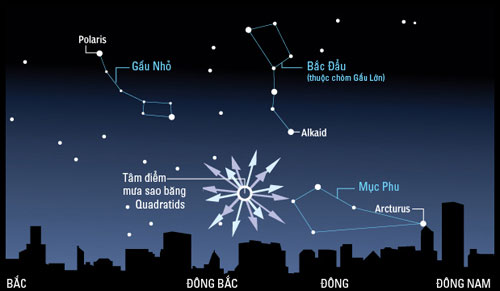Vietnam welcomes the first meteor shower of the year
Quadrantids - one of the largest meteor showers in the year will reach its peak on the morning of January 4 with a meteor number of up to 50 tracks / hour.
>>>18 outstanding astronomical phenomena in 2014
The time of the Quadrantids meteor shower is from December 28 to January 12, and the peak is usually around 3-4 January. As expected, East Asia is the best observation area for this meteor shower in the hours before dawn (2am-5am).

The sky contains the constellation of the center of Quadrantids.(Photo: NASA / Stardex / HAAC)
In Vietnam, the best time to observe is from midnight to dawn on January 4. Viewers should look to the east-northeast sky.
This year, the moon will set early and will not have much effect on the ability to observe star streaks. However, according to Mr. Dang Tuan Duy, a member of HCMC Amateur Astronomical Club (HAAC), the observation is a bit difficult in Vietnam. The reason is that at the extreme, the focal point of the meteor shower is not high enough for the horizon to have the most favorable observation conditions. Besides, the climax of this rain takes place within a few hours, so viewers need to take the time to admire as they wish.
Also according to Tuan Duy, at places near the equator on the northern hemisphere like Vietnam, or at places far from the north latitudes, the frequency of meteorological streaks is only about 30-50 streaks / h, still in south of the equator is very difficult to observe the rain of Quadrantids. While in optimal observation conditions, it can be up to 80-120 meteors per hour.
The Quadrantids meteor shower took place when the Earth in its orbit passed through the material dust deposits left by asteroid 2003 EH1 (first observed in 1825, according to NASA). Based on a number of studies, this object may be one of the remaining pieces of a comet when it shattered centuries ago, possibly comet C / 1490 Y1.
Most meteor showers are named after the constellations that contain their starting point. But the Quadrantids meteor shower is named from a now-defunct constellation - the constellation Quadrans Muralis, the constellation Measure the wall angle (Wall quadrans). This is a device used by ancient astronomers to measure the position of stars in the sky.
- Vietnam welcomes meteor shower in the morning of May 6
- Vietnam is about to welcome the most beautiful meteor shower of the year
- Vietnam welcomes Lyrids meteor shower
- Vietnam welcomes the biggest meteor shower in 10 years
- See the king of the upcoming meteor shower
- Vietnam is about to watch meteor shower
- Vietnam is about to welcome the biggest meteor shower of the year
- Moonlight will hinder observing the most beautiful meteor shower of the year in Vietnam
- Guide to observing the meteor shower of Leonids on November 17
- Choose a location to admire the most beautiful meteor shower tonight?
- Vietnam welcomed the first meteor shower in 2017, the maximum frequency of 100 tracks / hour
- Coming with the most beautiful meteor shower of the year
 Van Allen's belt and evidence that the Apollo 11 mission to the Moon was myth
Van Allen's belt and evidence that the Apollo 11 mission to the Moon was myth The levels of civilization in the universe (Kardashev scale)
The levels of civilization in the universe (Kardashev scale) Today Mars, the sun and the Earth are aligned
Today Mars, the sun and the Earth are aligned The Amazon owner announced a secret plan to build a space base for thousands of people
The Amazon owner announced a secret plan to build a space base for thousands of people